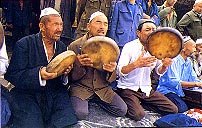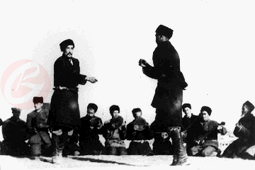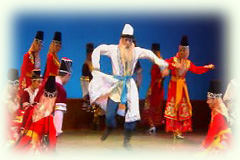| |
Dolan Dance
( 2005-09-13 )
 Unrestrained and vigorous, Dolan is an ancient Uygur folk dance popular in Maikeiti, Bachu, Shache, and Awati counties along the Yarkant River in Northwest China'sXinjiangUygur Autonomous Region. Unrestrained and vigorous, Dolan is an ancient Uygur folk dance popular in Maikeiti, Bachu, Shache, and Awati counties along the Yarkant River in Northwest China'sXinjiangUygur Autonomous Region.
Dolan is an ancient name for Uygurs living in several places in the Tarim Basin. With bravery, diligence, wisdom, and strength, they created an oasis on the edge of the Taklimakan Desert. Many people living in Maikeiti, Bachu, and Awati still call themselvesDolanpeople and the place they live,Dolan.
Dolanis said to describe hunting. "Call to the hunt" is followed by "searching for the prey with torches," "brave fight with the animal," "dauntless pursuit," "encirclement," and "joy over the triumph." From the vigorousmimefor shooting arrows people can visualize the hard lifeDolanpeople led in the past. However, some people say this dance depicts a battle.Dolanhas preserved most of its original characteristics.
The best performance ofDolanis found in Red Flag Township in Maikeiti, where men and women, young and old, love to dance it. A couple dance,Dolanhas four sets of dance movements, ending with a turning competition.
 After a good harvest people hold a party on a floodlit basketball playground. They sit in a circle while the dancers performDolanin the center. First, some people sing a prelude; then, while the drummers beat the drums vigorously, people rise to their feet to choose partners and start the dance (men and women usually dance separately). After a good harvest people hold a party on a floodlit basketball playground. They sit in a circle while the dancers performDolanin the center. First, some people sing a prelude; then, while the drummers beat the drums vigorously, people rise to their feet to choose partners and start the dance (men and women usually dance separately).
As the beat quickens, the dance becomes more exciting. Sometimes the couples touch at the shoulders, then separate like a whirlwind. The two dancers spin facing each other, before separating to vie with each other in a stunning display of turns. Finally one person remains, spinning to the right and left as the spectators clap, raise their thumbs, and shout, "Wu si ta! (Skilled dancer!)" Then the dance comes to an exciting and exuberant end.
 The most outstanding movements are a broad lunge and a bending and shivering of the knees. The lunge is a quick step or a dash, while the shivering movement is a bending and stretching of the knee that goes through the whole dance. These characteristic movements reflect theDolanpeople's past work and life in rugged mountain areas, swamps, and desert. The most outstanding movements are a broad lunge and a bending and shivering of the knees. The lunge is a quick step or a dash, while the shivering movement is a bending and stretching of the knee that goes through the whole dance. These characteristic movements reflect theDolanpeople's past work and life in rugged mountain areas, swamps, and desert.
Kalun,Dolanrawap,Dolanghij?k, tambourines, and other ancient folk instruments are used for accompaniment. Kalun, a plucked stringed instrument, is the principal instrument, producing fascinating music.Dolanrawap, another plucked stringed instrument, has a mellow tone. The ghij?k is a bowed four-stringed instrument. The tambourines play a particularly important role in the accompaniment. When the dance reaches its climax, the players often hold the tambourines over their head and beat them with their palms to inspire the dancers.
|
|

